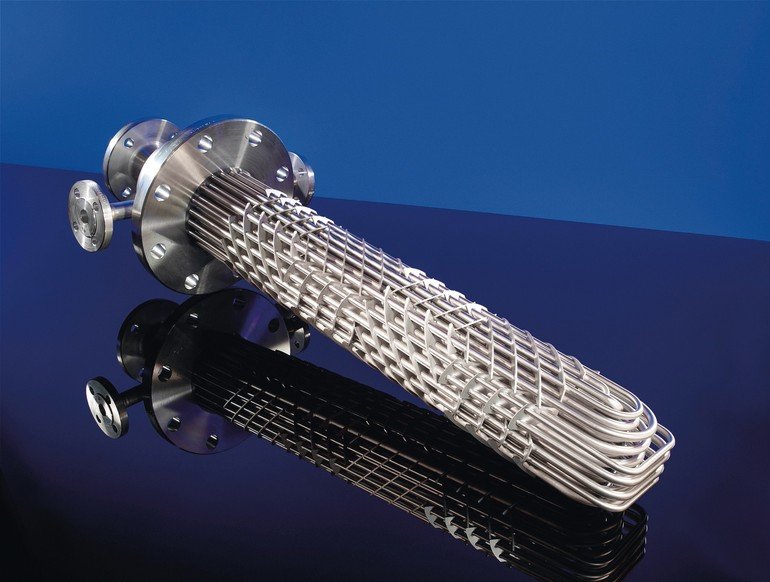Chemical processes are often developed directly today in continuous operation. Owing to the small reactor volumes and the high surface-to-volume ratio, even fast and highly exothermic reactions can be carried out safely in millireactors or microreactors. However, the question of safety requirements generally arises at the latest when these reactions are scaled up. Fluitec has developed a safety concept for assemblies and built a reference plant with a diameter of DN 50 for throughputs from 100 to 300 kg/h. The engineers responsible chose Fluitec’s proven, high-performance mixer/heat exchanger as the tubular reactor.
Safety classification
Although the reaction mass is only heated locally in a continuous process and there is a large heat-exchanging area, thermal runaway or an excessive pressure rise in the tubular reactor cannot be completely ruled out. If a hazardous incident of this kind occurs, measures must be in place to prevent it from propagating to the storage tanks and collecting vessels. In practice, these safeguards are dependent on the type of chemical reaction as well as on the process conditions. At the heart of the safety concept, therefore, is the division of continuous processes into safety classes 1 to 5 based on their temperature levels (modified diagram taken from F. Stoessel, Thermal Safety of Chemical Processes, Wiley-VCH, Weinheim 2008). This safety classification is determined by the relative positions of the following temperatures:
- TP – Process temperature range
- Tm = T0 + ∆Tad – Maximum temperature attainable under adiabatic conditions
- TS – Maximum allowable temperature of the pressure equipment; temperature at response pressure of the bursting discs or the safety valve
- TOnset – Onset temperature of the decomposition reaction
Safety classes 1 and 2 are considered to be «safe» because if the cooling system fails, the maximum attainable temperature (Tm) cannot initiate the decomposition reaction. In the case of class 3, the above-mentioned incident could cause the reactor to burst, while with safety classes 4 and 5 even a decomposition reaction is conceivable. Event-preventing protective devices such as a countercurrent safety purge system (SPS) should be installed for the class 3 to 5 reactions for this reason in addition to damage-limiting protective devices like a safety valve or bursting discs. The SPS is tripped if the maximum limit temperature which can just be handled without risk (TExo) is exceeded. The difference between the TOnset and TExo temperatures must be sufficiently large for enough time still to be available to trip purging before the decomposition reaction begins. This temperature difference is consequently dependent on the response time of the temperature sensors. Processes assigned to safety classes 4 and 5 are very critical because Tm is greater than TOnset. They must therefore be diluted, either with solvent or using a plug flow recycle reactor (PFRR), so that Tm is reduced to a value below TOnset and the safety classification of the reactions changes to class 1 or 2. Provided no secondary reactions occur with the product, Fluitec’s advice is to give preference to PFRR mode over dilution with solvent on environmental grounds.
Damage-limiting protective devices like a safety valve or bursting discs permit depressurisation if significant amounts of gas are produced, as is usually the case with decomposition reactions. Three pressure rise systems are possible:
- Gas-producing systems form non-condensable gases
- Vapour pressure systems follow the vapour pressure curve
- Hybrid systems are a combination of gassy and vaporous systems
A pressure rise due to vapour production can be absorbed to a large extent by the pressure equipment. In a gassy or hybrid system, the safety valve or the bursting discs respond.
Functional assemblies
The assemblies for fast and highly exothermic reactions are fitted with axial temperature sensors, pressure sensors and flow meters as standard. Furthermore, Fluitec’s experts equipped their reference plant with a safety purge system as an event-preventing protective device. The safety purge system is automatically activated, and the reactor emptied immediately, if the allowable temperature, pressure or flow limit is exceeded. The flow which exits from the plant is fed into a quench tank, causing the reaction to be instantly quenched. The hot liquid is thus prevented from spreading into the storage tanks and collecting vessels. Inert gases or liquids are particularly suitable for purging. The countercurrent safety purge system is an integral part of the plant and includes both mechanical and electronic components. It has SIL certification and can hence be used as a SIL protection level.
The component is equipped with a control system and has three SIL protection levels. Thanks to this high level of safety, the reactor is ideal for numerous liquid-liquid reactions. The control system was programmed with a standard operating manual and each process step is documented. Full traceability is ensured in this way. The software can be used for any reactor and adapted to meet additional process requirements without any problems. The following step sequences are integrated in the programming:
- Initial commissioning and recommissioning
- Start-up and running up (continuous/normal operation)
- Shut-down
- Removal from service including cleaning
- Sampling
Since operating regulations, certified components and risk analyses already exist, the process development time can frequently be halved.
Online search: cpp0119fluitec









